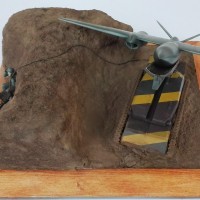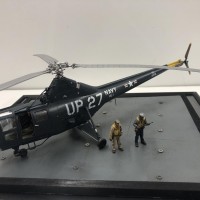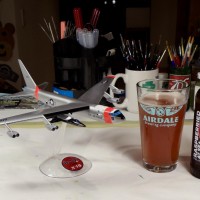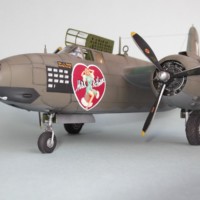Masking And Painting Strategies
When painting our models, we are often faced with challenges with regards to finishing the model. We have to balance requirements for different finishing techniques that often place restrictions on how we can apply them. For example, certain paints are more easily masked over than others. Metallics can peel when masked. Or if they do not peel, they may still have a change in appearance when the masking is pulled up.
Certain paint colors have poor coverage over other colors. White and yellow, and indeed, most lighter colors typically do not cover darker colors well without multiple layers of paint and often change their tone.
Decals should normally be applied over a gloss finish(although this has been debated) and should never be masked over unless over coated (which is still at risk of peeling the decal).
Masking for complex shapes often requires complex masking jobs which can lead to bleed through at the edges as well as often being tedious to accomplish.
I think most modelers probably think of finishing in terms of how something might be painted in real life. For example paints are always applied over bare metal (with or without primers). Markings on aircraft are generally always painted rather than accomplished with decals. And these markings are applied after the main paint scheme is accomplished. Different colors on aircraft are usually applied over the original paint work. So as modelers, we tend to finish our models in the same general order. Paint the metallics first (if applicable), or paint the main colors first, then apply the secondary colors, then apply decals. This often ends up running into the restrictions mentioned early.
Okay, bear with me here for a bit longer so I can give a little more context to this discussion. In the last two years, I have taken to painting markings on my models. Not in every case, but in some. And when doing natural metal finishes, I, like others, will simulate the finish by using various shades of metallics on different parts of the model. When I first started painting markings, I painted them over the base colors. And when I did different metallics, I masked and painted the previous applied metallics.
When painting markings, I realized fairly soon, that it might be better to paint the markings before the main colors. More on this in a moment. And when I was working on foiling my P-47N Thunderbolt, I was applying individual foiled panels. I noticed how easy it was to apply one panel right next to another panel as long as the panels ended on a panel line and a sharp knife was used to cut the foil. This all led to an epiphany with regards to painting and masking.
Okay, although I am still formulating the overall strategy to determine some rules of thumb, it works like this. I'll start with painting markings, but the strategy can also sometimes be applied to metallic finishes.
If one is painting the markings, and importantly, has access to painting masks (either aftermarket or through the use of a vinyl cutter like the Silhouette Portrait), then complex masking for markings is often easier. For example, you can paint lettering by simply painting the color of the lettering in an area, apply the masks in the appropriate location, and then move on to the next task.
If you were to do this after paint the main colors, you could make it easier if you have the female versions of a mask, but you would still have to contend with trying to paint a lighter color (usually) over a darker color. Also, female masks are often more difficult to place correctly. They may also not be possible in certain circumstances if the area being painted is really complex or the paint scheme is really complex. So I tend to paint my markings first and then mask them while I accomplish all the rest of the paintwork.
With metallics, you could apply this strategy in two different ways. First, markings could be painted first, before the metallic paints are applied, and then masked. Or, if some of the metallics you are using are less prone to peeling than some of the other metallics you plan on using, then these could be painted first, then masked and painting of the remaining metallics could take place. I don't have any photos of this particular strategy, but I plan on using it on an upcoming B-47 project.
The takeaway here is this. By planning ahead, and considering the restrictions that can occur in the finishing process, you can alter the order of finishing to reduce masking complexity and the risk of peeling or excessive paint requirements for coverage.
So finally, I wanted to put this article up to spark some general discussion and get feedback. Please feel free to post questions or feedback in the comments and I will endeavor to respond. And I would love to get other modeler's experiences and take on this.














@clipper
You make some valid points here Carl.
I also avoid masking over metallics being acrylics or lacquers, the exception being Gunze Supermetallic by the same reasons you speak (experience=pain)
Over non NMF shades I usually paint over (again an exception being large white or yellow surface areas). National insignia or minor areas, like fuselage bands, using white or lighter shades have never been problematic so far at getting good coverage without too much paint. Spray thin layers is my method.
Thanks for the feedback Pedro (@holzhamer). My coverage using lighter shades has been hit or miss. I do use thin layers, but I find that it takes so many (at least in my experience) that some underlying surface detail can be lost. Admittedly, that can happen with the approaches I mentioned in the article, but in general I find it easy to do things this way.
You can mask over the Tamiya lacquer metallics with no problem.
That has been my experience as well. I don't think I made that part of the article as clear. But the intent was that certain metallic paints can be used for the areas that are painted first since they are more durable under masking tape. Of course, determining which ones they are is up to the modeler to test because one person can have luck with metallics under masking, and another might find them nothing but trouble. For example, I have heard from others that AK Extreme Metal colors are very durable, but every time I mask over them, it leaves a change in the appearance, even if they do not peel. Perhaps it's all a matter of waiting longer. 🙂
G’day Carl (@clipper),
I usually prefer to paint fuselage bands and leading edges rather than use decals (particularly when the fuselage band has to meet up on the underside - to avoid decal overlap). I also pre paint coloured tails and noses.
The exception is where I want to replicate wear (see https://imodeler.com/2022/01/supermarine-spitfire-mk-viii-hava-go-jo/) and show the underlying camouflage.
I have only recently begun making my own stencils for lettering and national markings (see https://imodeler.com/2023/11/lockheed-t-33a-2/), but that was mostly because of old decal failure.
With better planning, your idea makes perfect sense.
Thanks for the feedback Michael (@michaelt). My use of masking for markings is a fairly recent change for me, but it has made it possible to get schemes I can't find in decals which is a real plus. I typically have to use a couple of decals even on these builds because my cutter is capable of cutting smaller masks unless the lines are fairly simple. On my Fury build, the under the tail serial number was a custom printed decal. The Jet Intake warning was too small to print or make masks and I had to use the kit decals. That was a chore on that build because the spelling was off!
An excellent article, Carl! Wonderful that you shared your thoughts on masking and painting based on your talent and experience. I use a number of your approaches and will definitely study carefully the rest, to see if I can implement them to my modeling approach.
Thanks for the feedback Spiros (@fiveten). I use this approach when it's warranted. Like all modeling techniques, not all situations can use the same approach. But it is definitely useful to me.
Thank you so much for this great article,Carl @clipper
Lots of very helpful tips to improve on masking and painting to improve the final looks of a model.
Even though I do use some of those, it is clear that you master those techniques far better than I do.
Thanks John (@johnb). Admittedly, I put this article out for myself as much as for someone else. It helps me to put my thoughts together better. I hope it can be useful to others.
Very useful Carl, thanks.
I am glad I could post something useful Tom (@tcinla)